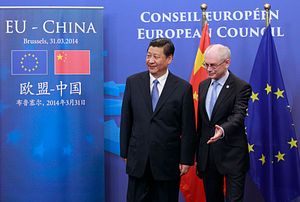Trans-Pacific View author Mercy Kuo regularly engages subject-matter experts, policy practitioners, and strategic thinkers across the globe for their diverse insights into U.S. Asia policy. This conversation with Bernt Berger – senior fellow and head of the Asia Program at the German Council on Foreign Relations; and founder and CEO of the Engagement Policy Centre in Berlin – is the 125th in “The Trans-Pacific View Insight Series.”
Explain the impact of the U.S. “Indo-Pacific” strategy on EU Asia policy.
The EU’s core interests in the region are stability, development, and the safety of investments and transport corridors. The EU has not felt the need for any counter-BRI [Belt and Road Initiative] strategy yet. This is not to say that the EU does not need a more comprehensive BRI strategy beyond the European Commission’s Connectivity platform.
A strategic alignment with the Indo-Pacific “Quad” [Australia, India, Japan, and the United States] is tempting for reasons of competition with China. However, the package involves a quasi-military alliance, which would run counter to the EU’s approach of strengthening regional solutions and cooperation. Only France and Britain have unilaterally indicated interest in a strategic alliance. But so far, their engagement has not gone beyond freedom of navigation operations. Overall, the greater challenge for the EU is to find solutions for a multipolar world that involves an increasing number of overlapping interests in the regions.
Assess the Indo-Pacific concept as a security construct.
As a concept of maritime safety at the confluence of Pacific and Indian Ocean, it helped the acknowledgment that both regions are indivisibly connected. Today, the concept appears to be far more ambiguous. This has to do with the individual interests of the four key actors and emergence of the parallel and now indivisible concept of a quadrilateral security partnership, or the so-called “Quad,” including Japan, India, Australia and the U.S. While maritime safety alone was a common concern in the region, including China, the Indo-Pacific partnership goes far beyond the initial idea. The concept now includes regional security, connectivity infrastructure, development in Southeast Asia and Africa, as well as a zone of shared values. This combination unmasks the initiative as a counterproject to China’s Maritime Silk Road, but also ASEAN’s Security Community.
The particular combination of a zone of economic development and shared strategic security with ostensibly shared values is polarizing and strongly resembles regional Cold War structures, including a return to defense perimeters in the Pacific Rim. The U.S. National Security Strategy of 2017 has identified the Indo-Pacific not only as a region of geopolitical or geoeconomical competition but also the hotspot for the clash between “free and repressive visions of world order.” In view of such a trend, China’s leadership can now feel vindicated in their approach of maintaining geostrategic stability and with it countercontainment. For other Southeast Asian countries, the construct is leading to more uncertainties rather than greater security. At the same time, it needs to be seen whether Quad countries (above all Australia) can sustain their opportunistic alliance, while depending on cooperation with China in many ways.
Is Indo-Pacific a countervailing approach to China’s growing influence? Explain.
If we define influence as the power to impact political decision-making, the question is which countries are in the region are of special concern and how this influence was used. So far it seems that China has made a footprint in a range of countries. China’s uncoordinated advances, often in the form of loans, have more often than not led to more mistrust rather than a new sphere of influence. Also, China’s BRI did not involve a security dimension beyond the safety of investments and transport corridors. Its priority of geostrategic stability in its neighborhood as a means to avoid major wars, and with it to guarantee its own rise, always conflicted with its economic integration initiative. Intensifying great power competition and perhaps even greater assertiveness will increase Beijing’s dilemma. A “countervailing approach” will not help but increase competition over influence. Consequently, smaller countries in the region will have to bear the brunt. Instead of choosing sides they will have to balance both side’s interests. The only way out of this situation is still a strengthening of regional mechanisms in the ASEAN framework.
How does the “Merkron” (Germany’s Angela Merkel and France’s Emmanuel Macron) leadership factor affect the EU’s approach to Asia?
Both rely on the EU’s economic clout that provides advantages on the international stage. Especially President Emmanuel Macron needs the EU and its relations with China in order to push France’s catch-up reform program. On the EU level, both might be interested to maintain the EU’s position as a soft security actor. At the same time, France will need to find a way to reconcile its growing economic engagement with China with its existing maritime strategy and military presence in the South China Sea.
Identify common policy interests the United States and EU share in engaging Asia vis-à-vis China’s regional leadership.
So far, the best argument for such a shared interest was that China’s fragile governance system and popular nationalism might possibly trigger military adventurism. But this scenario would be a matter of strategic preparedness rather than strategic competition in Asia. So far, the EU’s goal has not been to contain China’s regional role nor its rise. As a soft security actor, the EU is targeting diplomatic solutions for the consequences of a simultaneously globalizing and multipolarizing world.
The EU’s key shared policy interests with the U.S. lies in concerns about Chinese investment and trade practices that contravene international norms. Besides, financial solutions are needed in order to provide European companies with a competitive edge vis-à-vis Chinese SOEs that are oozing with money. In terms of security the EU has at this stage little to offer. The EU is not part of any alliance system itself. However, individual member states are indirectly committed to U.S. defense interests in East Asia via their NATO membership in case of an attack.

































